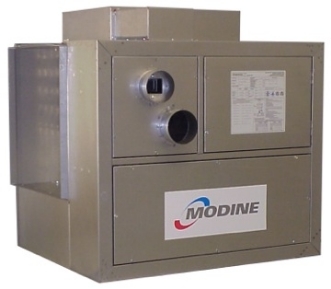Dehumidifier Corporation of America (DCA) provides top-notch indoor air quality and refrigerant-based dehumidification systems. If humidity is not controlled in commercial and industrial settings, it can lead to catastrophic results. Indoor pool rooms and facilities like printing, packaging, warehousing, and freshwater treatment plants require effective dehumidification, which involves maintaining proper room temperature. Add-on duct heaters are a common accessory to these dehumidification systems, preheating outdoor makeup air and limiting water evaporation into the indoor air.
At DCA, we offer a variety of add-on duct heaters, all of which come with a full range of customization options and are designed and manufactured in the United States. Learn more about our add-on duct heaters, how they work, and the applications best suited for each type.
Benefits of DCA’s Add-On Duct Heaters
In an indoor pool room, duct heaters can enhance the performance of a dehumidification system, providing the following benefits:
- Minimize water evaporation by raising the temperature of the room
- Maintain the desired room temperature (normally 2 to 4 degrees above water pool water temperature is ideal)
- Control humidity levels (Between 50 and 60 per cent relative humidity considered ideal)
- Prevent moisture buildup on condensable surfaces such as window glass and metal surfaces
- Reduce the risk of mold and mildew growth
- Reduce corrosion damage
- Improve comfort and overall air quality
- Increase dehumidification efficiency
- Reduce energy costs
- Extend system lifespan
Any facility with an indoor hot tub, swimming pool or spa must use a dehumidification system to protect the structure from high humidity levels that can have damaging effects.
In the past, residential properties with dehumidification systems did not utilize heaters and relied solely on the pool to heat the space. This method proved inefficient as the pool could never attain the desired temperature to minimize evaporation.
The optimal air temperature in a pool room must be two to four degrees above the water temperature. However, since every pool room has unique characteristics, the demands for heating and dehumidification can change.
These factors may include:
- Orientation of outdoor-facing window, doors or skylight glass surfaces
- R factor of all glass surfaces – double or triple pane glass mandatory
- Amount of makeup air
- Geographical location
- Wall and ceiling insulation – Installation of a non-permeable vapor barrier in walls and ceilings on the warm side of the insulation under the wall covering
Public buildings require outdoor makeup air, but when saturated with moisture, this air can corrupt the HVAC system of the commercial building. Having a dedicated outdoor air dehumidifier, equipped with a duct heater, provides a viable solution.
Product Overview
Since air temperature control and tempering outdoor makeup air are vital to many applications, DCA offers three distinct styles of add-on duct heaters designed to work with any of our models. We provide electric duct heaters, gas duct furnaces, and hot water coils. Each type of add-on duct heater has distinct advantages in achieving the desired room temperature.
Gas Duct Furnaces
DCA offers gas duct furnaces, strictly for Non-Residential or commercial applications. They are not tested or rated for residential use, so we instead recommend an internal hot water coil option that uses an external gas-fired hot water boiler for residential use.
All our commercial gas duct furnace models feature stainless steel heat exchangers to prolong the unit’s lifespan and are power vented to ensure adequate draw via the burner compartment. We carry an extensive line of units certified by the Electrical Testing Laboratories (ETL) for safety and operate on a standard 115 volt single-phase household current, ranging from inputs of 100,000 BTU to 400,000 BTU to meet the demands of any commercial application.
Key features of our gas fired duct furnaces:
Indoor and Outdoor Gas Duct Furnaces
DCA carries two main types of add-on gas duct furnaces: indoor separated combustion duct heaters (DFS models) and power exhausted duct heaters (HFP models) for outdoor air installation.
-
Indoor Gas Duct Furnaces
INDOOR GAS DUCT FURNACES
DFS models feature separated combustion and are designed for indoor commercial use only. They are typically located either directly mounted near or downstream from the dehumidifier. Separated combustion insures that combustion air is taken from the outdoors only and exhausts outdoors as well.
Key features of indoor gas duct furnaces:
- Heating capacities between 100,000 and 400,000 BTU
- Operates on propane or natural gas
- Requires minimum voltage of 115 VAC
- Includes standard three-year parts warranty
- Dimensions vary by model, ranging from 36″ x 26.5″ x 33″ to 36″ x 47.5″ x 37″
- Stainless steel heat exchangers
- Two-stage or modulating gas valves
- Many other standard options

-
Outdoor Gas Duct Furnaces
OUTDOOR GAS DUCT FURNACES
Power vented duct heaters are outdoor gas duct furnaces that serve as the primary heating source for a commercial building. Certified for non-residential applications only, power vented furnaces are installed downstream from the dehumidifier and eliminates the risk of an erratic chimney.
Key features of outdoor gas duct furnaces:
- Heating capacity between 100,000 and 400,000 BTU
- Operates on propane or natural gas fuel
- Requires a minimum voltage of 115 VAC
- Includes standard three-year parts warranty
- Dimensions vary by model, ranging from 33.5″ x 34.5″ x 36″ to 33.5″ x 55.5″ x 40″
- Stainless steel heat exchanger
- Two-stage or modulating gas valves
- Many other standard options


Electric Duct Heaters
As add-ons to dehumidification systems, electric duct heaters are a common way to add pool room heating. They are the top choice for residential applications. They can also provide supplemental heat in commercial, institutional, and industrial applications.
The key features of electric duct heaters include:
Technical Specifications
Horizontal and Vertical Dehumidifier Heaters
Available in a broad range of sizes with standard heating capacities up to 110 kW, electric duct heaters are a versatile add-on duct heating solution. They operate on 208 V, 230 V, 460 V, or 575 V and are UL-listed for compliance and safety. DCA’s add-on electric duct heaters are suitable for use with various HVAC and dehumidifier systems. It is important to determine that sufficient power, in the breaker box, is available to power the electric heater.
Two types of installation options include:
-
Direct-Mounted

Direct-Mounted:
Compact design ideal for minimal space requirements with easy installation that mounts directly into the dehumidifier.
-
Slip-In

Slip-In:
Designed to slip into existing ductwork without requiring modifications. Minimal space requirements.
Upgrade Your Heating System with Our Add-On Duct Heaters today!
Duct heaters play a vital role in the dehumidification process, and Dehumidifier Corporation of America offers top-quality add-on duct heaters for an array of industries and applications. Our complete duct system package can manage heat and humidity while controlling the room temperature.
Contact us to upgrade your heating system today!
Want to learn more troubleshooting tips ?
We’ve only looked at three common problems here, but there are a host of other issues that can cause dehumidifier malfunctioning.
To read more about what can go wrong with dehumidifiers and learn how to fix problems quickly and efficiently, download our free dehumidifier troubleshooting guide today.
Download our Free Troubleshooting Guide
Looking for additional information?
View All Resources


Trusted By:




















